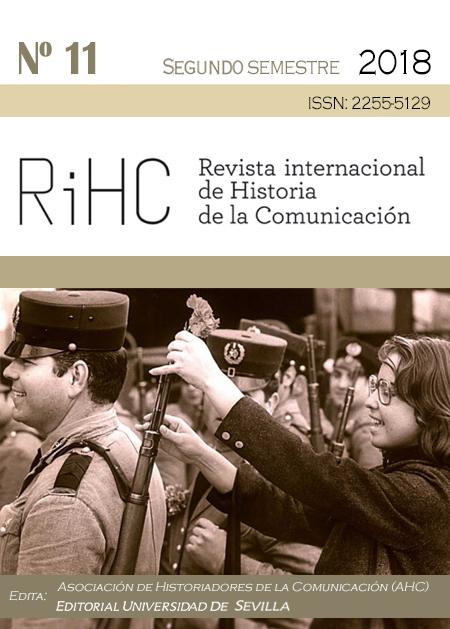Ethno-iconographic Vogue’s editorials (1948-2016): an approach to cultural diplomacies
DOI:
https://doi.org/10.12795/RiHC.2018.i11.09Palavras-chave:
Fashion magazines, photography, ethnography, cultural studies, cultural diplomacy.Resumo
This article offers an overview of a seminal research that has laid its foundations in a systematization of the messages emerging from the interface between different cultures through fashion communication and image making. It delves into a semantic study on the variety of compositions related to ethno-iconography that have been developed by western editions of Vogue since 1948. In parallel, it examines the continuity of their visual discourses by recent non-western editions. It explores the relation between the functions of the fashion magazines per se, and those of the travel magazines, ethnographic photography and even documentary photojournalism. From this interpretative framework, the study assess the potential of fashion magazine as an instrument that provides visibility to social realities and that acts as triggers of critical reflection and agents capable of establishing inter-cultural relations.
Downloads
Referências
ADAM, I. and H. TIFFIN (eds.) (1991): Past the Last Post: Theorizing Post-Colonialism and Post-Modernism. New York: Harvester Wheatsheaf, p. vii.
BARLETT, D., (2006): “In Russia, At Last and Forever: The First Seven Years of Russian Vogue,” in Fashion Theory Journal, Vol. 10, no. 1&2, 2006, pp. 175-204.
CHEANG, S., (2013): “’To the Ends of the Earth’. Fashion and Ethnicity in Vogue Fashion Shoot,” in Bartlett D., Cole, S. and Rocamora, A. (editors), Fashion Media: Past and Present, London, Berg, pp. 35-45.
CRAIK, J., (1994): The Face of Fashion: Cultural Studies in Fashion. London: Routledge.
DEFERT, D., (1989): “Un género etnográfico profano en el siglo XVI: los libros de trajes (ensayo de etno-iconografía),” in RUPP-EISENREICH B. (editor), Historias de la Antropología (siglos XVI-XIX), Madrid, Ediciones Júcar, pp. 24-38.
DESERPS, F., (1567): Recueil de la diversité des habits, qui sont de présent en usage, tant es pays d'Europe, Asie, Affrique & isles sauvages, le tout fait après le natural. Paris: Imprimerie de Richard Breton. doi: ark:/12148/bpt6k102756w.
GIENOW-HECHT, J. C. E. and DONFRIED, M. C. (2013): Searching for a Cultural Diplomacy. New York, Berghahn.
HWAJUNG, K., (2011): “Cultural Diplomacy as the Means of Soft Power in an Information Age.” Online (April, 2018)
JOHNSON, W. (1866): The oriental races and tribes, residents and visitors of Bombay: a series of photographs with letter-press descriptions, London, Bolton and Barnitt.
JONES, A. R., (2006): “Habits, Holdings, Heterologies: Populations in Print in a 1562 Costume Book,” in Burland M., LaGuardia, D. and Tarnowski, A. (editors), Meaning and Its Objects: Material Culture in Medieval and Renaissance France, New Haven, Yale University Press, pp. 92-121.
JORA, L., (2013) “New Practices and Trends in Cultural Diplomacy,” in Romanian Review of Political Sciences and International Relations 10, no. 1, 2013. Online (April, 2018): http://journal.ispri.ro/wp-content/uploads/2013/03/43-52-Lucian-Jora.pdf
LUTHER, N. and DEEN DAYAL, R. (2003): Raja Deen Dayal: Prince of Photographers, Hyderabad, Hyderabad in.
MENÉNDEZ MENÉNDEZ, M. I., (2009): “Aproximación teórica al concepto de prensa femenina,” in Comunicación y Sociedad, Vol. XXII. no. 2, 2009, pp. 27-34.
PENN, I., (1974): Worlds in a Small Room, New York, Grossman Publishers.
PUDDICK, M. and PRIYA, M., (2012): “Contemporary Luxury,” in
ATWAL G. and JAIN S. (editors), The Luxury Market in India: Maharajas to Masses, New York, Palgrave Macmillan.
SANDHU, A., (2015): Indian Fashion: Tradition, Innovation, Style, London/New York, Bloomsbury.
THEUWS, M. and OVEREEM, P., (2014): Flawed Fabrics. The abuse of girls and women workers in the South Indian textile industry, Amsterdam/Utrecht, Centre for Research on Multinational Corporations and Indian Comitee of the Netherlands.
TIMMONS, H., (2008): “Vogue’s Fashion Photos Spark Debate in India,” The New York Times. Online (April, 2018): (http://www.nytimes.com/2008/09/01/business/worldbusiness/01vogue.html?_r=0
ZORACH, R., (2005): Blood, Milk, Ink, Gold: Abundance and Excess in the French Renaissance, Chicago, The Univer
Downloads
Publicado
Como Citar
Edição
Secção
Licença
RiHC. Revista internacional de Historia de la Comunicación es una publicación de acceso libre, ofrece su contenido bajo el principio de que hacer disponible gratuitamente la investigación al publico apoya a un mayor intercambio de conocimiento global.
RIHC. Revista internacional de Historia de la Comunicación se adhiere a las diferentes iniciativas que promueven el acceso libre al conocimiento, por lo que todos los contenidos son de acceso libre y gratuito y se publican bajo licencia de Creative Commons Reconocimiento-NoComercial 4.0 Internacional.

En virtud de ello, los autores que publiquen en esta revista aceptan las siguientes condiciones:
Los autores conservan los derechos de autor y ceden a la revista el derecho de la primera publicación, con el trabajo registrado con la licencia de atribución de Creative Commons, que permite a terceros utilizar lo publicado siempre que mencionen la autoría del trabajo y a la primera publicación en esta revista.
Los autores pueden realizar otros acuerdos contractuales independientes y adicionales para la distribución no exclusiva de la versión del artículo publicado en esta revista (p. ej., incluirlo en un repositorio institucional o publicarlo en un libro) siempre que indiquen claramente que el trabajo se publicó por primera vez en esta revista.
Se permite y recomienda a los autores publicar su trabajo en Internet (por ejemplo en páginas institucionales o personales) ya que puede conducir a intercambios productivos y a una mayor y más rápida difusión del trabajo publicado (vea The Effect of Open Access).
No prevé moving wall o período de embargo
Debe utilizarse la versión de editor/PDF
La fuente editorial debe reconocerse













